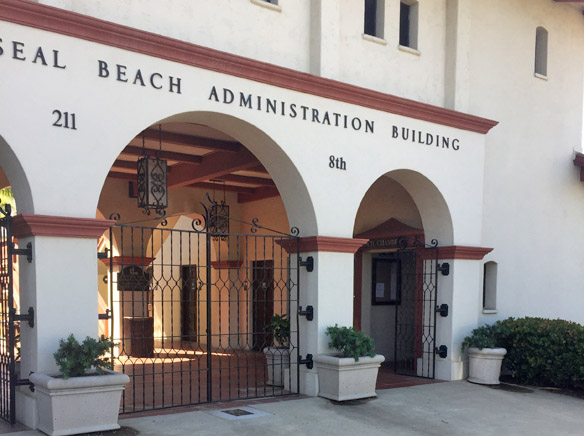Cities on San Gabriel River have until 2030 to install trash capture devices
Cities along the San Gabriel River have until 2030 to install catch basins to keep trash out of the river.
Seal Beach staff have installed 55 catch basins and has a grant pending to install another 48 catch basins, according to John Hunter of John Hunter and Associates.
According to Hunter, Seal Beach is on track to meet the deadline.
Hunter’s firm provides environmental consulting service to city governments. Hunter updated the City Council on the problem of trash going into the San Gabriel River at the Monday, Sept. 23, City Council meeting.
The issue isn’t new—nor is it really news—to Seal Beach residents. This past weekend, Save Our Beach volunteers participated in the monthly beach cleanup.
Historically, trash goes into the river, some of it washes up on the beach, and Seal Beach gets to pay for the cleanup.
Hunter started his presentation to the council by going over the basics:
• San Gabriel River is 58 miles long.
• The watershed covers 689 square miles.
• There are 43 cities upstream from the river.
“Quite a number of players on this,” Hunter said.
He explained that LA and Orange County cities and counties are subject to statewide trash provisions, which have given local communities until 2030 to install catch basins to keep trash out of the water.
He said LA County cities have been ordered to by their Regional Water Board to start installing the catch basins. Orange County cities have not, according to Hunter. He said the reasons for this are a matter of speculation.
“Full capture devices” will have to be installed in certain areas. According to Hunter, the full capture basins are designed to prevent flooding in the event the basins are clogged with debris. He described them as stainless steel baskets.
Hunter said booms are not always effective, just because of the volume of water that comes out of the mountains.
Hunter also talked about trash skimmers, such as the trash wheel in Newport Bay. However, Hunter said they would not work in moving water.
Later in the meeting, Seal Beach Planning Commissioner Robert Aguilar disputed that. He said he spoke with the inventor of the skimmer in Newport Beach, and according to Aguilar, the skimmer was designed to work in moving water. He has called for the installation of such a device to capture the San Gabriel River trash before it comes ashore in Seal Beach.
According to Hunter, Los Angeles County cities are required to install 10% of the required catch basins per year. However, Hunter expected the installation activities to accelerate with the passage of Measure W.
Some cities, Bellflower to name one, have already installed 100% of the catch basins.
Hunter said an ad hoc group has been formed to find a feasible method of installing the basins.
“The funding is limited in Orange County at this point,” he said.
The Orange County Transportation Authority has been administering a voluntary grant funding program since fiscal year 2011-2012.
He said most cities are moving toward the target.
“Seal Beach is ahead of the curve on installing these,” he said.
He suggested Seal Beach work with other cities to obtain grant funding.
It was at this point in the meeting that Hunter said Seal Beach was on track to meet the deadline.
According to Hunter, as less and less trash from the cities goes into the river, trash from homeless encampments becomes more and more noticeable.
District One Councilman Joe Kalmick asked what the city could do with the larger trash that appears to come from homeless encampments or the illegal dumping from up river.
Hunter said LA County Flood Control has an illegal dumping program. However, Hunter said the program is overwhelmed.
Kalmick pointed out that there is a sea turtle population in the area. He asked if that fact could be used for political capital.
Hunter said the environmental groups don’t need any more motivation to protect the sea turtles.
Hunter said the San Gabriel River is maintained by Los Angeles County Flood Control. He doubted the LA Flood Control would approve the installation of a boom. He speculated that they would adopt a wait-and-see approach.
He said the Army Corps of Engineers has jurisdiction over the area.
According to Hunter, working with the Army Corps of Engineers would add four years a permitting process.
Hunter said he didn’t see any reason why a boom wouldn’t be doable, but it would have to go through the “bureaucratic maze.”
District Three Councilman Michael Varipapa asked if there was any provision for cleaning out trash capturing devices.
Hunter said that would be developed by each city. He knew some cities monthly. Most cities clean them out three times a year. A few cities, he said he hated to say, clean them once a year or as complaints come in.
Hunter said there would be “enormous fines” if cities don’t have the capture devices installed by 2030.
Varipapa requested a list of the cities that are in compliance to date when Hunter gives Seal Beach his next update.
Hunter said that information was not readily available.
Aguilar called on Seal Beach to look at getting Prop. 1 funding. He also called on the city to move faster.
District Five Councilwoman Sandra Massa-Lavitt said it was forward-looking of staff to install catch basins.
Mayor Thomas Moore asked if it would help to work with other cities to reduce the time to install the basins.
Hunter said it was realistic. He said most cities would try to move forward. “We’re entering uncharted waters, so we’ll see how that works,” Hunter said.
City Manager Jill Ingram thanked representatives of Assemblyman Tyler Diep and State Senator Tom Umberg for their attendance at the council meeting.
City officials have been working with staff from both Diep’s office and Umberg’s office.












